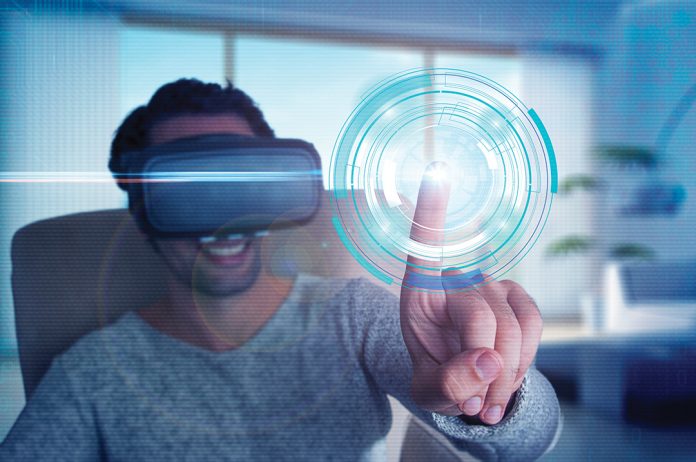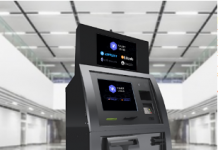The 25th Gentlemen’s Club EXPO wasn’t Don Kleinhans’ first rodeo. He’s exhibited at prior EXPOs, but this August, Kleinhans decided to go into the tradeshow with an open mind. Flanked by his son Blake and technical partner Yoshi, Kleinhans’ goal was to just present the technology of LV Networks.
 What their booth got was a line that wrapped around the tradeshow block, attendees craning their neck to catch a glimpse of the future.
What their booth got was a line that wrapped around the tradeshow block, attendees craning their neck to catch a glimpse of the future.
“I really enjoyed watching the people, especially in their 50s and older, experience—many for the first time—putting a VR headset on and to sit and experience the immersive aspect of VR,” says Kleinhans.“I’d watch them turn their heads, look up and down, all within the VR environment. They’d take their headsets off and just sit there in a little bit of shock.”
As Kleinhans puts it, LV Networks is an evolution of his Club Cam Systems mainstage and dressing room live feed software, which serves as a vehicle to generate monthly paying memberships for patrons to watch live feeds of their favorite adult nightclubs and/or entertainers. However, in the seven years since its inception, LV Networks has created more of a primary focus on VR and 360-degree immersion due in part to the rise in popularity and growth within the virtual reality market.
“Where our LV Networks 360 VR comes in is that if a club already has live cameras and the membership base, the VR is just an added feature,” Kleinhans says. “Eventually, we expect to see virtual reality become the bulk of our business.”
Kleinhans isn’t just in the technology business either, he is an ACE board member and has been the operating partner of 2001 Odyssey for almost 25 years, where his brother Jim Kleinhans is the general manager. 2001 is a staple landmark gentleman’s club in the Tampa area, well known for its movie-inspired name and “spaceship” perched atop its building. For a club that seems to embrace science fiction, it certainly isn’t a stretch to see it embrace a “futuristic” product like VR. At EXPO, Kleinhans was ready for the questions surrounding virtual reality and augmented reality that peppered him at the LV Networks booth.
“What I like to do is get with the other owners, being a club owner myself and being in the business for more than 25 years, and talk to the ones that have the immediate defensive position of, ‘No, I’m a brick-and-mortar guy, all this is going to do is take customers away from the clubs.’ I explain to them that our numbers at 2001 Odyssey, as far as customer patron flow, have done nothing but increase since we’ve added the live cameras. I had some fun conversations in that regard with Michael J. Peter and Harry Mohney, showing them technology is nothing to fear, it’s something to embrace.”
Even without the VR aspect, the live camera streaming LV Networks offers is a draw in and of itself. Patrons flock from around the world to 2001 Odyssey based on the club’s website, 2001live.com, to put a physical face to the digital performance.
“It’s one of the best marketing tools we’ve had at the Odyssey in the last 20-some years,” Kleinhans says. “I’ve never seen anything work like this.”
Drag and drop it, zip – unzip it
If your curiosity is piqued at the prospect of tapping into the infinite expanses of an online market base, then your mind has surely come across the pricetag such an endeavor carries.
As Kleinhans explains, the cost is two-pronged. First, a club has to be on board with utilizing the Club Cam System approach of putting the club live on the internet, which creates a membership base—the vehicle to have paying members available. Once a club expresses that interest, LV Networks gives that club contact information for suppliers that carry cameras that LV Networks recommends.
“We tell them what type of local installer to find—the same people that install security cameras or telephone systems,” Kleinhans says. A club will also need to add some routers to increase outgoing bandwidth (i.e. more devices to give the camera the strength to push the feed). Kleinhans says they just provide information, and don’t make any markups on cameras or any of the equipment. That part of the installation process can run anywhere between $5,000-$8,000.
“Once that’s installed, (the club) contacts us at our offices and we connect to their routers and we do a revenue split using our software, their equipment and their club,” Kleinhans says.
The VR gets a little pricier. For example, the camera 2001 Odyssey uses in their dressing room is around $4,700. But as with any new gadget/technology, the astronomically high prices inevitably come back down to earth.
Kleinhans mentions that it isn’t so much the technical implementation that’s the tricky part of taking a club online as much as it is the paperwork involved with placing live cameras in an adult establishment. This can be summed up by the number 2257, which states under federal law that producers of a “visual depiction of an actual human being engaged in actual sexually explicit conduct” are required to keep records showing the ages of the models.
“It’s very important that 2257 reporting requirements are met by any club that decides to go live,” Kleinhans stresses. “We’ve had clubs that tried to participate and management was reluctant to keep up with paperwork, so we’ve turned those cameras off. You have to dot the i’s and cross the t’s, and if you’re not going to do that, it’s not worth it to have your club go live on the internet.”
“Millennials have grown up with video game controllers in their hands. They’re not going to turn 18 or 21 and just forget or change their culture as far as their interest in gaming, or technology or being online. A good club owner that sees the future embraces the fact that these millennials will possibly find the club online (and) possibly interact with the club online.” – Kleinhans
So you have the requisite
technology installed. Now what?
Being as familiar as they are with the adult nightclub industry, LV Networks knows operating a club alone can be a hassle. “We know when you tell the GM or the floor manager or a DJ that there’s an added task, they roll their eyes and have something to say about it,” Kleinhans says. “So we made implementation as easy as possible.”
With a few clicks and gestures of the mouse, a DJ can let the cyber audience know when a certain entertainer is onstage and performing. From there, viewers can tip or “make it rain” courtesy of an ATM-like apparatus that’s built into the club’s ceiling.
“It’s a simple process, but it has to be done otherwise the end user at home can’t tip the entertainer,” Kleinhans says. “We take care of billing, the technical end, the server. You just have to make sure the cameras are on and functioning.”
The future waits for no club
While there will undoubtedly be a share of club owners who bristle at the notion of virtual entertainment operating within their walls, virtual reality is emblematic of the larger problem the industry has been slow to grapple with.
“Our industry has to embrace technology,” Kleinhans reasons. “We can’t sit on our hands and say, ‘We only have brick-and-mortar clubs and we only sell juice or liquor and the customers will keep coming in.’ Millennials have grown up with video game controllers in their hands. They’re not going to turn 18 or 21 and just forget or change their culture as far as their interest in gaming, or technology or being online. A good club owner that sees the future embraces the fact that these millennials will possibly find the club online, possibly interact with the club online. But a club may get passed by if it doesn’t position itself on the internet or in technology.
“No matter what the technology, it will never replace the experience of a personal one-on-one interaction with an entertainer,” Kleinhans adds. “The reality of technology 100% replacing physical touch and human interaction, especially in an environment such as a men’s club, I think is a very, very long way away.”
For more information, visit LVnetworks.com.




































